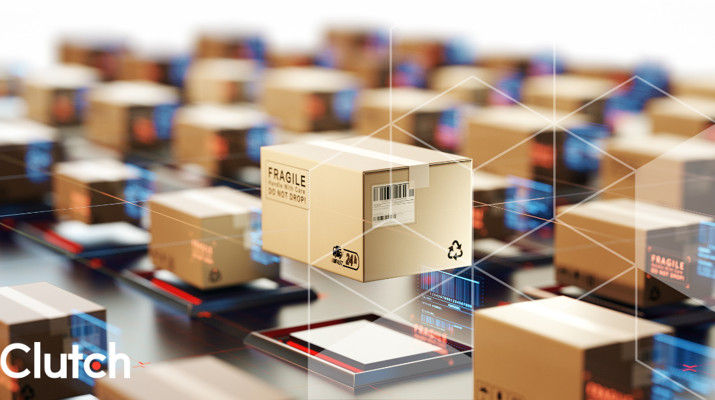

Updated April 10, 2025
In 2019, Clutch found that online shoppers’ interest in a product dramatically decreases even with small increases in the shipping cost. Businesses should consider offering free shipping to meet customers’ shipping cost expectations. They also can try building shipping costs into their products’ prices.
Updated May 11, 2022
There’s a $30 hat you have been looking at online for some time now. It’s cheap and fashionable. You decide to take the plunge and put it in your online shopping cart, eager to check out. The final price pops up on the screen: $32.99 after shipping.
Looking for a Logistics & Supply Chain Consulting agency?
Compare our list of top Logistics & Supply Chain Consulting companies near you
You waver. Suddenly, the hat is less appealing when it’s more than $30. The $2.99 shipping cost decreases your interest in the hat.
2019 analysis from Clutch confirmed that the appeal of free shipping may often be less about actual cost savings than customers’ unwillingness to pay extra fees. The extra $2.99 creates a mental barrier to purchase because the customer expected a $30 item.
We surveyed more than 500 online shoppers in 2018 to learn what they expect to pay for shipping when purchasing different items online.
Is free shipping worth it for businesses? The answer may not surprise you.
Our data points to key challenges businesses experience with shipping costs. We found that:
Based on the data, businesses should strongly consider offering free shipping if they don’t already. Is free shipping worth it? The answer seems to be yes.
Worried about the cost of free shipping? Businesses can try building shipping costs into their products’ prices.
Businesses may think they can please customers and still earn money by keeping shipping costs cheap but not free. Our data shows that even small increases in shipping costs decrease customers’ interest in a product, though.
In our 2018 data, thirty-four percent (34%) more online shoppers said they’re “very likely” to order an item they’re considering if the shipping cost is free versus only $2.99.
Broken down, 77% of online shoppers said they’re very likely to order an item they’re considering if the shipping cost is free. Only 43% said the same when the shipping cost is $2.99.
That means you could lose more than one-third of customers due to a $2.99 difference in price. This has likely increased recently, with more shopping options online than ever before.
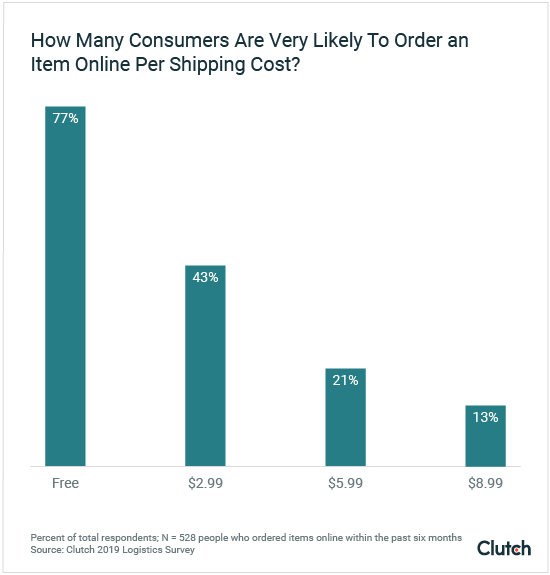
The likelihood of ordering an item goes down further as shipping costs increase. Twenty-one percent (21%) of online shoppers said they are very interested in the product with a $5.99 shipping cost and only 13% of online shoppers said the same if the shipping cost is $8.99.
The desire for free shipping applies to both sweaters and sofas.
A similar number of online shoppers in 2018 expected free shipping for small items (32%) and large items (30%) alike.
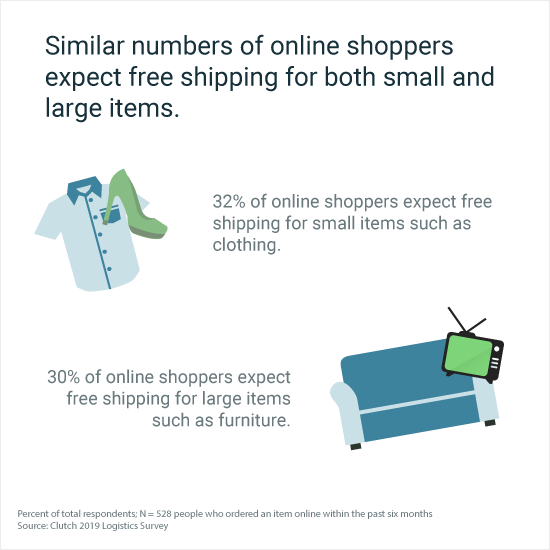
Free shipping for a book or shirt seems easy to offer. When a business needs to ship a sofa or a television, though, it can feel harder to justify free shipping.
Online shoppers expect free shipping, even if they aren't ordering on Amazon.
Amazon first experimented with offering free shipping for certain orders in 2000. Since then, both the media and experts point to Amazon’s long-time push for free shipping as the reason why it’s popular among e-commerce consumers. Amazon’s size allows it to set standards for the entire industry; the e-commerce giant made $232.89 billion in product sales in 2018. In 2021, sales increased to over $241 billion.
Amazon invests large amounts of money in its shipping and fulfillment, and these costs now equal a full quarter of its topline revenue.
We found that free shipping is no longer only popular among only Amazon’s customers. A similar number of Amazon Prime members and non-Amazon Prime members expect free shipping when they order an item online.
A little more than one-third (34%) of Amazon Prime members expected free shipping for small items such as clothing in 2018. Twenty-eight percent (28%) of non-Prime members expected the same.
The data is similar for larger items such as furniture. Thirty-two percent (32%) of Amazon Prime members expected free shipping for large items, compared to 27% of non-Prime members.
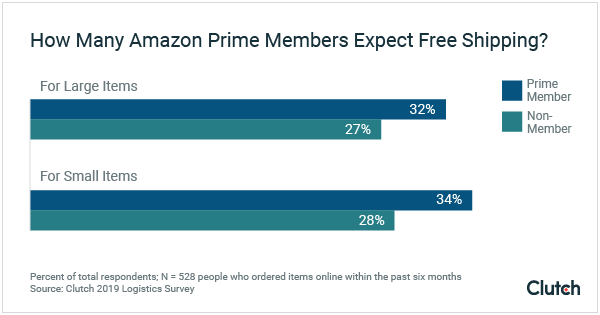
Free shipping is expected across the e-commerce industry.
Additional Reading: '7 Ways to Optimize Your Mobile Commerce Site'
Our data shows the importance of offering free shipping to meet online shoppers’ expectations. Business owners, though, may complain that free shipping will decrease profits. There’s a solution: Build the cost of shipping into your products’ prices.
For example, instead of listing a hat for $30 with a $2.99 shipping price, price it at $32.99. While the product’s price is higher, customers also know exactly what they have to pay from the beginning, reducing lost conversions.
Including shipping costs into products' prices doesn't work for every business. For example, the strategy assumes the business is paying the same shipping cost for all customers. In reality, shipping costs differ greatly depending on how far you are sending the product. However, including shipping costs into products' prices works for many small business owners.
We spoke with several small business owners in 2018 and 2019 about how they meet customers' demands for free shipping. Many said they include shipping in the cost of some, if not all, of their products.
Lorenzo Ritson owns an online apparel shop and offers free shipping on every product.
“When a customer [adds] an item to their cart, moves into the checkout process, and sees the added cost of shipping, they will be significantly less likely to go through with the purchase decision,” Ritson said. “Offering free shipping has allowed us to convert more customers and increase sales.”
“Offering free shipping has allowed us to convert more customers and increase sales.”
Ritson still adds the cost of shipping into his products’ displayed prices. “This simple psychological trick decreases a customer’s cognitive dissonance and allows them to feel more confident going through the purchasing process,” Ritson said.
Stacy Case sells vintage items on her Etsy shop. She adds shipping costs into the price of the products she sells domestically.
“I have always worked the shipping cost into my domestically sold items because when shoppers are browsing, they can see the full cost immediately,” Case said. “For me, there is nothing worse than finding a wonderful $6 item only to find out the shipping cost is outrageously high.”
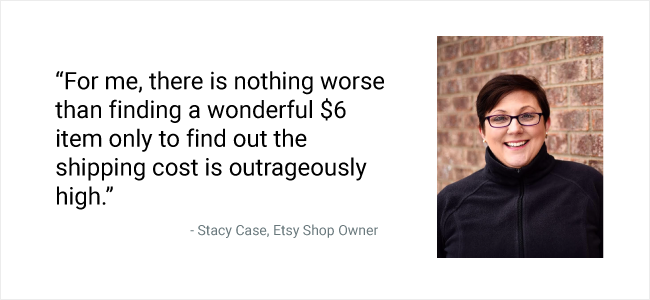
Michael Anderson is a marketing specialist for GeoJango Maps, which sells push pin travel maps.
Anderson says that people increasingly expect free shipping: “Retailers should be able to meet this need even if it means increasing prices or accepting a small reduction in profit.”
Small business owners can try adding shipping costs into their products’ prices. This may help them retain customers who would otherwise leave without purchasing after seeing shipping costs.
Check out our 2022 small business advertising report to see how businesses are marketing their products online.
Online shoppers don’t like shipping costs, even when they’re low. This is still true in 2022.
In 2018, approximately one-third fewer online shoppers said they are very likely to purchase an item even if the shipping cost is even only $2.99 compared to free shipping.
Nearly one-third of online shoppers expect free shipping for both small and large items. There isn’t a large difference in free shipping expectations between Amazon Prime members and non-members.
Businesses should consider building the cost of shipping into products’ prices to decrease shoppers’ dislike of extra fees.
Look through our directory of logistics service providers for current research on the industry.
Clutch surveyed 528 people who ordered a package online in a span of six months in 2018.
More than half of the respondents (66%) are female, and 34% are male.
The respondents' ages are as follows: 18 to 24 (16%), 25 to 34 (33%), 35 to 44 (26%), 45 to 54 (16%), and 55 to 64 (9%).
Respondents are all based in the U.S., either in the South (42%), Midwest (21%), Northeast (17%), or West (14%).

